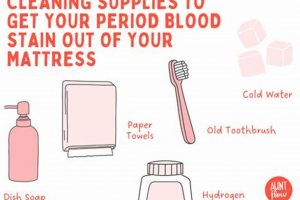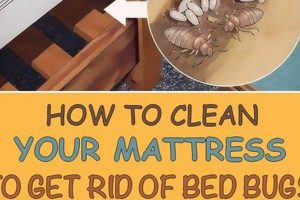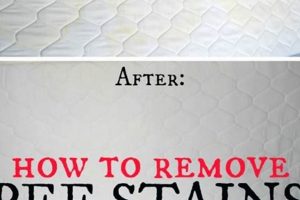The removal of urine from a mattress is a process centered on eliminating both the visible stain and the associated odor. Effective treatment typically involves absorbing excess liquid, cleaning the affected area with a specialized solution, and ensuring complete dryness to prevent the growth of mold or bacteria. This task can be addressed through DIY methods or professional cleaning services.
Prompt and thorough action offers several benefits, including the preservation of the mattress’s lifespan and hygiene. Lingering urine can degrade the mattress materials over time and create an unsanitary environment. Historically, various household remedies have been employed for this purpose, demonstrating a long-standing need for effective cleaning techniques.
Subsequent sections detail specific methods and cleaning agents appropriate for addressing urine contamination in mattresses. The outlined procedures aim to provide comprehensive guidance, enabling individuals to effectively tackle the problem and maintain a clean and healthy sleep environment.
Tips for Mattress Urine Removal
Effective urine removal from mattresses requires a strategic approach focusing on prompt action and appropriate cleaning techniques.
Tip 1: Immediate Action is Crucial. The fresher the stain, the easier it is to remove. Absorb as much liquid as possible with clean cloths or paper towels by blotting, not rubbing.
Tip 2: Utilize Absorbent Materials. Generously apply baking soda to the affected area after blotting. Baking soda helps to absorb remaining moisture and neutralize odors. Allow it to sit for several hours, or preferably overnight, before vacuuming.
Tip 3: Employ Enzyme-Based Cleaners. Enzyme cleaners specifically designed for pet stains are often effective in breaking down urine components. Follow the product instructions carefully, ensuring adequate ventilation during application and drying.
Tip 4: Consider a DIY Cleaning Solution. A mixture of white vinegar and water (1:1 ratio) can be used to clean the stained area. Apply the solution sparingly, blot with a clean cloth, and allow to air dry thoroughly.
Tip 5: Ensure Thorough Drying. After cleaning, drying the mattress completely is critical to prevent mold or mildew growth. Use fans or a dehumidifier to expedite the drying process. In some cases, leaving the mattress in direct sunlight can also aid in drying, but should be done cautiously to prevent damage to the material.
Tip 6: Test Cleaning Solutions. Prior to applying any cleaning solution to the entire stain, test it on a small, inconspicuous area of the mattress to ensure it does not cause discoloration or damage.
Tip 7: Vacuum Thoroughly. After any dry treatment, such as baking soda, vacuum the mattress thoroughly to remove all residue. Use a hose attachment to reach all areas.
Adhering to these tips maximizes the likelihood of successful urine stain and odor removal, contributing to a cleaner and more hygienic sleep environment.
The subsequent section will address preventative measures to minimize the occurrence of future mattress contamination.
1. Absorb promptly
The principle of prompt absorption is foundational to effective urine removal from a mattress. Delay in addressing the spill allows for deeper penetration into the mattress fibers, complicating subsequent cleaning efforts and potentially leading to persistent odor and staining.
- Minimized Penetration
Quick absorption restricts the urine’s ability to seep deep into the mattress layers. This reduces the surface area affected and simplifies the extraction process. For instance, immediately blotting a fresh spill with absorbent cloths minimizes the fluid’s downward migration, preventing it from reaching lower layers of padding.
- Reduced Odor Retention
Urine odor arises from the decomposition of its organic components. When absorbed promptly, the quantity of organic matter binding to the mattress fibers is reduced. A delayed response, conversely, permits these compounds to bond more strongly, resulting in a more persistent and difficult-to-eliminate odor. The effectiveness of odor neutralizing agents is greatly diminished if significant urine saturation has occurred.
- Decreased Stain Severity
The longer urine remains in contact with the mattress fabric, the more pronounced the stain becomes. Prompt absorption reduces the duration of contact, thereby limiting the staining effect. Materials like mattress ticking can be susceptible to discoloration, and immediate action mitigates the severity of this discoloration. Failure to act quickly may necessitate more aggressive cleaning methods or professional intervention.
- Prevention of Mold and Bacteria Growth
Moisture trapped within a mattress provides a conducive environment for mold and bacteria proliferation. By rapidly absorbing the urine, the moisture level is reduced, thereby inhibiting the growth of these microorganisms. Subsequent drying efforts are also more effective when the initial volume of liquid is minimized through prompt absorption. Untreated moisture can lead to long-term health concerns and mattress degradation.
The practice of prompt absorption is a primary defense in the effective removal of urine and preservation of mattress hygiene. It is the initial step in a comprehensive cleaning strategy, facilitating the action of subsequent treatments and ultimately contributing to a cleaner and healthier sleep environment.
2. Neutralize Odor
Odor neutralization is a critical component of successful urine removal from a mattress. Addressing the stain alone is insufficient; the lingering odor, if not properly neutralized, can persist and affect the overall hygiene and usability of the mattress. Specific techniques and agents are necessary to eliminate the source of the odor at a molecular level.
- Enzymatic Action
Enzymatic cleaners contain specific enzymes that break down the uric acid crystals present in urine, which are primarily responsible for the characteristic odor. These enzymes target the chemical bonds of uric acid, converting them into odorless compounds. Unlike simple masking agents, enzymatic cleaners address the root cause of the odor, providing a more permanent solution. Without enzymatic action, residual uric acid continues to emit odor, especially in humid conditions.
- pH Balancing
Urine is typically acidic, which can contribute to odor retention within mattress fibers. Utilizing agents that neutralize the pH can disrupt the odor-causing compounds. For instance, baking soda, an alkaline substance, can be applied to the affected area to neutralize the acidity and absorb lingering odor molecules. Balancing the pH reduces the volatility of the odor-causing components, diminishing their ability to permeate the surrounding environment.
- Odor Absorption
Certain materials possess the capacity to absorb odors at a molecular level. Activated charcoal, for example, has a porous structure that traps odor molecules. Applying activated charcoal or similar absorbent materials to the treated area can further reduce residual odor. This method works by physically binding the odor compounds, preventing their release into the air. The effectiveness of odor absorption depends on the material’s porosity and surface area.
- Ventilation and Airflow
Promoting thorough ventilation and airflow after cleaning aids in the dissipation of remaining odors. Increased airflow accelerates the evaporation of volatile odor compounds, allowing them to dissipate into the surrounding air. Positioning fans or opening windows in the room can significantly enhance this process. Adequate ventilation is often essential to fully eliminate lingering odors, even after chemical treatments have been applied.
These facets of odor neutralization are indispensable to comprehensively addressing urine contamination in mattresses. Failure to properly neutralize the odor can lead to persistent discomfort and require repeated cleaning attempts. Effective odor neutralization, in conjunction with stain removal and prevention measures, ensures the long-term hygiene and usability of the mattress.
3. Enzyme Cleaners
Enzyme cleaners constitute a specialized category of cleaning agents particularly relevant to the effective removal of urine from mattresses. Their mechanism of action differs significantly from conventional detergents, making them uniquely suited for breaking down the complex organic compounds found in urine.
- Targeted Breakdown of Uric Acid
Urine contains uric acid crystals, which are the primary source of its persistent odor and can be difficult to remove with standard cleaning methods. Enzyme cleaners contain enzymes, such as urease, that specifically target and break down these uric acid crystals into smaller, odorless compounds. This targeted degradation is more effective at eliminating the odor source compared to masking it with fragrances.
- Decomposition of Organic Matter
Beyond uric acid, urine also contains other organic components, including urea and proteins, that contribute to staining and odor. Enzyme cleaners contain a variety of enzymes, such as proteases and amylases, capable of breaking down these complex organic molecules into simpler, water-soluble substances. This process facilitates the removal of both the stain and the associated organic residues during cleaning.
- Safe for Mattress Materials
Many conventional cleaning agents contain harsh chemicals that can damage or discolor mattress fabrics. Enzyme cleaners, when formulated appropriately, are generally considered safer for use on a wide range of mattress materials, including natural fibers like cotton and wool. The enzymatic action is specific and targeted, reducing the risk of damage compared to broad-spectrum chemical cleaners. However, pre-testing on an inconspicuous area is still recommended.
- Elimination of Residual Odor
Even after thorough cleaning with conventional methods, residual urine odor may persist due to deeply embedded organic compounds. Enzyme cleaners penetrate into the mattress fibers to break down these remaining compounds, effectively eliminating the odor at its source. The continuous action of the enzymes ensures a more complete and lasting odor removal compared to surface treatments.
The use of enzyme cleaners represents a targeted and effective approach to addressing urine contamination in mattresses. Their ability to break down the complex organic components of urine, coupled with their relative safety for mattress materials, makes them a valuable tool in restoring mattress hygiene and eliminating persistent odors. While other cleaning methods may provide temporary relief, enzyme cleaners offer a more fundamental solution by addressing the underlying cause of the problem.
4. Thorough Drying
Thorough drying is an indispensable element of any process aimed at urine removal from a mattress. Inadequate drying efforts can negate the effectiveness of prior cleaning treatments, resulting in persistent issues and potential long-term damage to the mattress. The connection between the two lies in the prevention of secondary problems arising from residual moisture.
Residual moisture, left after cleaning, creates a favorable environment for mold and bacterial growth within the mattress fibers. This growth can lead to unpleasant odors, allergic reactions, and structural degradation of the mattress materials. For instance, a mattress cleaned to remove a urine stain but not adequately dried may develop a musty odor within days, signaling microbial activity. The success of stain and odor removal hinges on the ability to eliminate all traces of moisture following cleaning. Proper ventilation, the use of dehumidifiers, or even sunlight exposure, are employed to ensure complete dryness. Commercial mattress cleaning services often utilize specialized extraction equipment to minimize residual moisture, underscoring the importance of this step.
In summary, thorough drying is not merely a concluding step but an integral component of the cleaning process. It prevents the growth of mold and bacteria, eliminates residual odors, and preserves the integrity of the mattress. Overlooking this aspect can render the entire cleaning effort futile, resulting in recurring problems and potentially shortening the lifespan of the mattress. Proper execution of this step is critical for a successful outcome.
5. Stain Removal
Stain removal is a central objective in addressing urine contamination within a mattress. Effective stain removal restores the aesthetic appearance of the mattress and contributes to overall hygiene and sanitation. The process requires a targeted approach to eliminate visible discoloration and prevent long-term material degradation.
- Identification of Stain Composition
Effective stain removal begins with understanding the nature of the staining agent. Urine stains consist of organic compounds, including urochrome, which imparts color. Knowing the composition allows for selecting appropriate cleaning agents that target these specific compounds. For instance, stains primarily composed of urochrome may respond well to bleaching agents, whereas those with significant protein content require enzymatic cleaners.
- Selection of Appropriate Cleaning Agents
The choice of cleaning agent is critical to prevent further damage to the mattress material. Harsh chemicals may effectively remove stains but can also cause discoloration, weakening of fibers, or residual odors. Enzyme-based cleaners are often preferred due to their ability to break down organic matter without causing significant harm. Spot testing in an inconspicuous area is advisable to assess the compatibility of the cleaning agent with the mattress material.
- Application Techniques for Stain Extraction
Effective stain removal requires the application of appropriate techniques to extract the staining agent from the mattress fibers. Blotting, rather than rubbing, minimizes the risk of spreading the stain and damaging the material. Applying the cleaning agent from the outside of the stain inward can prevent further expansion. Sufficient dwell time, as recommended by the cleaning agent manufacturer, allows the solution to penetrate the stain effectively.
- Post-Treatment Assessment and Drying
Following stain removal, thorough assessment is necessary to ensure the stain has been adequately addressed. Remaining discoloration may require a second treatment or a different cleaning agent. Complete drying is crucial to prevent the formation of mold and mildew, which can lead to further staining and odors. Utilizing fans or dehumidifiers can accelerate the drying process and minimize the risk of secondary problems.
These facets of stain removal are integral to the comprehensive approach to addressing urine contamination. Targeted stain removal efforts, when combined with odor neutralization and preventative measures, contribute to restoring the mattress to a hygienic and usable condition.
6. Prevent recurrence
The principle of preventing the recurrence of urine contamination is inextricably linked to the overall strategy of effective mattress hygiene. While addressing an existing urine stain is crucial, implementing preventative measures mitigates the likelihood of future incidents, reducing the need for repeated and potentially damaging cleaning procedures. This preventative approach serves as a fundamental component of maintaining the mattress’s condition and prolonging its lifespan.
The primary method of preventing recurrence involves the use of mattress protectors. These barriers, typically waterproof or water-resistant, shield the mattress from liquid penetration. A high-quality mattress protector effectively contains spills, preventing urine from reaching the absorbent layers of the mattress. For example, families with young children or pets often utilize mattress protectors to guard against accidents. Their use simplifies cleanup, as the protector can be easily removed and laundered, safeguarding the mattress from direct contact with urine. Furthermore, routine replacement of mattress protectors maintains a clean and hygienic sleep surface. Addressing underlying causes of incontinence, where applicable, also contributes to reducing the risk of future incidents.
In summary, preventing the recurrence of urine contamination is integral to the holistic management of mattress hygiene. The application of protective measures, such as waterproof mattress covers, reduces the incidence of future stains and protects the mattress from sustained damage. The understanding of this connection is important for efficient and effective mattress maintenance, ensuring a cleaner and healthier sleep environment.
Frequently Asked Questions
This section addresses common inquiries regarding the removal of urine from mattresses, providing concise and factual information to guide effective cleaning practices.
Question 1: Will standard household cleaners effectively remove urine stains and odors from a mattress?
Standard household cleaners may address surface stains; however, they often lack the enzymatic action required to fully break down urine components and eliminate embedded odors. Specialized enzyme cleaners are typically recommended for optimal results.
Question 2: Is baking soda alone sufficient for removing urine odor from a mattress?
Baking soda is an effective odor absorbent; however, it primarily addresses surface-level odors. While beneficial as a component of a cleaning process, it may not completely eliminate deeply embedded urine odors. Comprehensive cleaning strategies that incorporate enzymatic action are often necessary.
Question 3: How quickly must urine be addressed on a mattress to prevent permanent damage?
Prompt action is crucial. The sooner urine is addressed, the less likely it is to penetrate deeply into the mattress fibers, reducing the severity of staining and odor retention. Immediate blotting and treatment are advisable.
Question 4: Can professional mattress cleaning services guarantee complete urine removal?
Professional services offer specialized equipment and expertise, enhancing the likelihood of complete urine removal. However, the success depends on factors such as the age and severity of the stain, as well as the mattress material. Guarantees may vary among providers.
Question 5: Does sunlight exposure effectively disinfect a mattress after urine contamination?
Sunlight possesses disinfecting properties; however, it may not penetrate deeply enough to eliminate all bacteria and odor-causing compounds within the mattress. While beneficial as part of a cleaning process, it should not be considered a sole method of disinfection.
Question 6: Are waterproof mattress protectors completely effective in preventing urine from reaching the mattress?
High-quality waterproof mattress protectors offer significant protection; however, their effectiveness depends on proper fit and material integrity. Tears or improper installation may compromise their ability to prevent urine penetration. Regular inspection and maintenance are recommended.
Effective urine removal from a mattress requires a multifaceted approach, incorporating prompt action, appropriate cleaning agents, and thorough drying techniques. Preventing recurrence through the use of mattress protectors is an essential element of long-term mattress hygiene.
The subsequent section will address preventative measures to minimize the occurrence of future mattress contamination.
Conclusion
The preceding information has comprehensively addressed the multifaceted problem of how do you get urine out of a mattress. Key points include the importance of prompt action, the targeted use of enzymatic cleaners, the necessity of thorough drying to prevent microbial growth, and proactive preventative measures such as mattress protectors. Successful resolution depends upon adhering to these principles.
Urine contamination poses a significant challenge to mattress hygiene and longevity. Vigilance and informed action are essential to maintain a clean and healthy sleep environment. Consistent application of the recommended techniques offers the best defense against the damaging effects of urine and supports the long-term preservation of the mattress.







